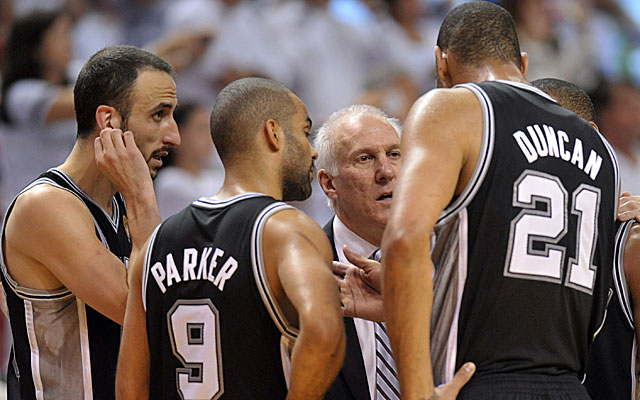 By Dr. Tim Rice
By Dr. Tim Rice
Contributor, Sports+Fitness Network
As most sport fans witnessed recently, the San Antonio Spurs provided a flawlessly executed performance in the 2014 NBA Finals. As someone who has been involved in basketball for 30 years, I have never seen a more cohesive team as this Spurs team. Many have stated that they played the game the way it should be played on both ends of the floor. The passing stats and margins of victory speak volumes to the way they played team basketball. Even Spurs star Manu Ginobili stated, “I think what we did was very important. It was different. The way we played, the way everybody got involved in every possession, it was a lot of fun. I don’t know if it was unprecedented, but it’s not as common for sure.”
Another uncommon thing: the Spurs had the most international players in NBA history. This team had 10 international players to start the season with many different languages and cultures meshing under the watchful eye of Gregg Popovich and staff. Their opponents, the Miami Heat, had an entire team of US players. How did the Spurs have such chemistry and cohesiveness compared to the Heat considering their differences? Could the rest of the NBA (and professional sport in general) learn something from this?
Ironically enough, there is not much in the scholarly literature that looks at how international diversity on a team can impact success in sport:
There was one study that looked at the effect of team racial composition on team performance in NBA by using the Herfindahl-Hirschman index (HHI) to examine the degree of diversity found on the NBA championship teams from 2005-06, 2006-07, & 2007-08. This study found that team diversity was “neither an asset nor a liability to team performance” (Weiss & Sommers, 2009).
Brandes, Franck, & Theiler (2009) actually looked at the effect of national diversity on sports team performance. These researchers hypothesized that “the productivity of the sports team will lessen with the number of nationalities due to language barriers.” However, they did state that “the introduction of nations and aspects of different cultures will eventually result to additional skills within the team” and “the influence of national diversity on team performance relies on the nature of the fundamental task.”
Outside of the sport spectrum, an article found in Kellogg Insight based on a Phillips and colleagues’ 2009 study found that difference in a group causes tension, which leads to a better end result for the group. Much like happened in this year’s NBA Finals, the diverse group in this study surpassed the more homogeneous group because the differences represented in the diverse group brought a new influx of ideas that were not found in the more homogeneous group.
Could this have been the difference maker for both teams in the NBA Finals? Was this version of the Spurs more focused on “the fundamental task” of winning the championship after their disappointment in 2013? And how did leadership from Popovich and his team leaders, Tim Duncan, Tony Parker, and Ginobili, in addition to this diversity make a difference in their success?
Regarding the last statement, perhaps the earlier diversity findings can also be combined with some professional literature from Linda Flanagan, a girls’ cross-country coach of New Jersey’s Kent Place School. She offered several factors that led her team to surprise the experts as they won the New Jersey state title in 2013: 1. The team was prepared; 2. They had spirit; 3. They wanted it; 4. The coaches were partners with the team members; & 5. They internalized the team mottoes instilled in them from the start.
I think the Spurs team members and staff fit these five standards well. Either way, the Spurs have offered the world of professional sport a possible paradigm shift. With all of the changes coming up in free agency (specifically, the Miami Heat), one would wonder if some teams will follow the lead of the San Antonio Spurs.
References
Brandes, L., Franck, E., & Theiler, P. (2009). The effect from national diversity on team production- Expirical evidence from the sports industry. Schmalenbach Business Review (SBR), 61(2), 225-246.
Buckley, Z. (2014, June 28). How will Miami Heat spend record $55 million cap space after Big 3 opt out? Bleacher Report. Retrieved from http://bleacherreport.com/articles/2113084-how-will-miami-heat-spend-record-55-million-cap-space-after-big-3-opt-out.
Flanagan, L. (2014, June 20). The mysterious makings of a winning team. The Huffington Post. Retrieved from http://www.huffingtonpost.com/linda-flanagan/the-mysterious-makings-of_b_5516207.html.
KelloggInsight. (2010, October 29). Better decisions through diversity [Blog post]. Retrieved from http://insight.kellogg.northwestern.edu/article/better_decisions_through_diversity
McCarney, D. (2014, June 17). Passing stats illustrate Spurs dominance in Finals [Blog post]. Retrieved from http://blog.mysanantonio.com/spursnation/2014/06/17/passing-stats-illustrate-spurs-dominance-in-finals/.
McCarney, D. (2013, October 29). Spurs break their own record for foreign players [Blog post]. Retrieved from http://blog.mysanantonio.com/spursnation/2013/10/29/spurs-break-their-own-record-for-foreign-players/.
Weiss, J. & Sommers, P. (2009). Does team racial composition affect team performance in the NBA? Atlantic Economic Journal, 37(1), 119-120.
















